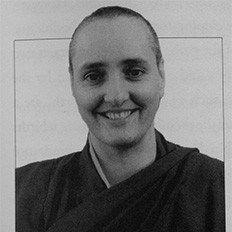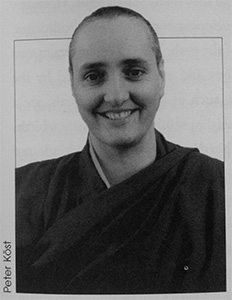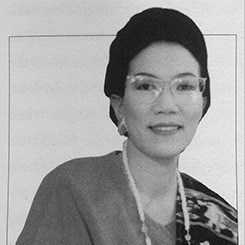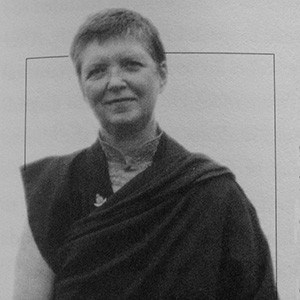A practical approach to Vinaya

From Blossoms of the Dharma: Living as a Buddhist Nun, published in 1999. This book, no longer in print, gathered together some of the presentations given at the 1996 Life as a Buddhist Nun conference in Bodhgaya, India.

Bhikshuni Jampa Tsedroen
What is a practical approach to Vinaya? My teacher, Geshe Thubten Ngawang explains it involves a good understanding of karma. Although I cannot profess to having this, I have noticed that the more I contemplate karma and the teachings related to it, the stronger my wish to practice Vinaya grows. This leads me to believe that if one has a good understanding of karma and its effects, Vinaya arises naturally.
Some Westerners see Vinaya as merely a system of rules and regulations that exists outside of us. Perhaps this is because, in our limited understanding, we associate Christian monastic discipline with many restrictions. However, in Buddhism, Vinaya is the basis for developing concentration, bodhicitta, wisdom, and all the other realizations of the path. Why? It counteracts two kinds of faults: naturally negative actions and actions prohibited by the Buddha. All naturally negative actions, such as killing as so forth, are a hindrance to the path to liberation because they result in unfortunate rebirths in future lives. In addition, actions prohibited by the Buddha are a hindrance because they prevent good qualities from developing in our mindstream. Thus, following ethical discipline as taught in the Vinaya eliminates hindrances caused by unwholesome behavior and establishes a firm foundation for gaining the higher realizations of the path.
I must study more to understand the complete meaning of Vinaya. However, in the more than fifteen years that I have been learning Buddhism, I have continuously been getting closer to Vinaya practice. The Vinaya contains the means for the way of life that I seek. If we try to behave in accord with the Dharma and look to the Vinaya for guidance, we will find that many important points are explained there. For example, at the end of the Pratimoksa Sutra, we find seven guidelines for ending disputes among members of the monastic community. These help resolve conflicts and show how to respect all sentient beings. Vinaya teaches us how to behave in a humble way and how to be satisfied with few things. Rather than try to procure something that is not available, we need to cultivate patience and be satisfied with the situation as it is. Vinaya also instructs us on how to live together harmoniously. In fact, if we understand Vinaya deeply, we can see the entire path to liberation in it.
If we are not able to practice Vinaya, we will not be able to develop a stable meditation practice. Keeping a certain discipline is the basis from which we begin. If we start with high Tantric practices, but lack stable discipline, we are sure to run into difficulties or to harm others or the Dharma. For a beginner such as me, Vinaya is most beneficial, as I can turn to it for practical daily guidelines.
Learning the various precepts is important. There are different categories of precepts according to their gravity: the defeats (parajika), the remainders (sanghavasesa), and so on. We are not capable of keeping every precept at the beginning. Therefore, the masters advise us to start with avoiding the most serious faults. A practical approach is to learn the main precepts—the defeats and remainders—as soon as we receive ordination. As beginners, we violate precepts each day; as human beings in the desire realm, we cannot altogether avoid violating them. But at least we can minimize the harm and take care not to transgress any of the major precepts completely, thereby losing our ordination. In this way, we can learn one precept after another, first trying to keep the major precepts strictly, and as time goes by following suit with the minor precepts. This is the way the Tibetan monastics train in their communities.
This approach is a natural one, being neither too strict nor too lax. Avoiding these extremes, each person must find for him- or herself the middle way to practice. It is very difficult to keep all the precepts literally, especially at the beginning, and we should avoid having grandiose expectations of ourselves or others. Speaking personally, I feel that I took ordination too quickly, although I do not regret it now. I had practiced the Dharma as a lay person for only one year when I was ordained, and I had to grow and am still growing into a “coat” that is too big for me. I am very fortunate to still be a nun! But I do not suggest that others quickly take ordination as I did. Similarly, I took the bodhisattva and Tantric precepts too early, and now am slowly making the best of it. However, if we took precepts too quickly, we should not regret it later, but understand that at the time we took the precepts we did so with the best motivation of which we were capable. After having taken them, we need to follow them and use the opportunity to learn.
The gradual approach
At Tibetisches Zentrum in Hamburg, if people want to take ordination, we do not accept their request immediately. Many Westerners want to be ordained just after encountering the Dharma, but I think many of them confuse their strong interest in the Dharma with the need to become a monastic. Many have a romantic view of the monastic life that does not usually have much to do with the reality of living as a monk or a nun in the West.
When people who attend classes at the center request ordination, we usually suggest that first they move closer to the center, continue to work at their job, and attend the seven-year systematic Buddhist study program that we offer. This program is comprised of five years of philosophy covering the four tenet systems, one year of Lamrim (Gradual Path to Enlightenment), and one year of Vinaya and Tantra. Those who do not instantly relate to the philosophy courses can start with the Lamrim and study the other topics later.
We do not require people studying Buddhist philosophy or attending meditation classes at our center to be Buddhists; they can also be Christians and so forth. Presently some psychologists and some university professors who teach comparative religion attend the program. We provide them with the information they need, and that serves their purpose. However, if people come to classes at our center and feel at home with the Buddhist way of thinking, they may become Buddhists if they wish.
When people strongly feel that they would like to become Buddhists, they take refuge by doing the refuge ceremony that our teacher conducts. If they want to take the five lay precepts, we suggest they study the transcripts of the Vinaya lectures of the seven-year program. In these, Geshe Thubten Ngawang gives a general introduction to Vinaya and explains the five lay precepts and other essential points about the Vinaya. After people have read this teaching thoroughly, we ask them to examine whether they are able to keep the lay precepts. If they are, they may take them. Some lay people want to go a step further and take the brahmacarya precept, which means that they give up not only sexual misconduct, but also sexual intercourse.
Generally, people can request monastic ordination only after they have finished the seven-year program. This was not the case years ago at our center, which is why I ordained so quickly. However, we have seen or heard of many Westerners who have given their vows back. They left school or their jobs when they ordained, and when they later returned to lay life, they had difficulties because they had not completed their education and so forth. They then remained on the periphery of society. This gives people a bad impression of Buddhism in the West. Since Buddhism is new in the West, if the public comes to think that we train people who then become outsiders in society, the Dharma will not spread.
A central land
Some Western Buddhists feel that monastics are outdated, that reform is needed, and that the monastic life can be abolished. However, a number of us feel that people should have the opportunity to choose the kind of lifestyle suitable for themselves and thus monasticism should be preserved as a viable option. In addition, monastics can contribute to the existence and spread of the Dharma in society. Indeed, the scriptures explain that for a country to be considered a central land where the Dharma flourishes, the four categories of disciples of the Buddha—the laymen (upasaka), laywomen (upasika), bhikshus, and bhikshunis—must exist. Since we appreciate the Dharma and hope it will remain for a long time, it is therefore important to ensure that these four groups continue to exist.
For me, the process of becoming a bhikshuni was difficult. Initially, I did not know of any bhikshunis in the Tibetan tradition. Before I became a nun, my teacher told me that by taking the novice precepts (sramanerika) I would become a sangha member, but one is allowed to do certain things only when one is fully ordained. Then I heard that Venerable Lekshe Tsomo was trying to find out about full ordination for women and that it might be available in some countries. At that time, I did not feel it was appropriate to raise the question with my teacher because I was busy enough learning the thirty-six precepts.
I was the first person to become a monastic in our center. Later some monks were ordained and they gradually went on to take the full ordination. However, there was no way for me to do that, and for many years I suffered because of this. My teacher is very compassionate and each year we asked His Holiness the Dalai Lama about the research the Tibetans were doing on the bhikshuni ordination. But each year he said that if I was in no special hurry, it would be better to wait one more year. Then in 1985, we asked His Holiness again, and he said, “Now I feel it is the right time to go.” I was so happy and said to my teacher, “Now I can go!” But he responded, “Yes, His Holiness said you could, but I do not feel it is good for you to go now.” You cannot imagine how much I cried! He said that he felt I did not have the proper motivation. “The correct motivation for going for full ordination,” he said, “is renunciation of cyclic existence. You should not seek full ordination because you want to have equal rights with the monks.” He knew what he was saying, and because it was true, it was so painful for me to hear. I really suffered. However, gradually I turned my motivation around, and at the end my teacher offered me the air ticket to go to Taiwan to receive the ordination. Subsequently he has helped me so much to learn the Vinaya.
I feel that bhikshuni ordination should be more widely available to those women who sincerely want to take it. Introducing it into the Tibetan tradition would be an enrichment. I no longer see any hindrances to this happening. It is only a question of time, but it will happen. For the Tibetan nuns, it still depends on whether or not they feel they need this ordination. But for Western nuns, I have no doubt. As I mentioned above, the Buddha said that for a country to be a central land where the Dharma flourishes, the four kinds of disciples must be present. If bhikshunis are missing, a place cannot be considered a central land. If they are present in a country as one of the four groups of disciples, then the Dharma can last there for a very long time.
However, we need to take care who enters the monastic community and how its members behave. Monks and nuns need to be well mannered when they interact with society, keeping their precepts and wearing their robes properly. We have seen some Westerners who wear the signs of an ordained person although they have only the five lay precepts. People see them living together with a boyfriend or girlfriend and become confused. If discipline is lax and mixed up like this, the public will no longer know the meaning of being a monastic. For this reason, if someone wants to enter monastic life (Tibetan: rab ‘byung), we ask them to do it together with the sramanera (male novice) or sramanerika (female novice) vow taken on the same day. In Tibetan society, it is very clear that people who become monastics will leave the household life and their family and enter a monastery. Although they may have to wait for some time to take the novice vow, they enter the monastic life, live in a monastery, and follow the monastic discipline, including abstaining from sexual contact.
If we do not take responsibility for how the monastics behave, the Dharma will be spoiled. Moreover, since many of us Western monastics are pioneers in the place we live, we must be aware that we represent not only the Dharma, but also the Sangha. This is a big responsibility, and His Holiness the Dalai Lama has said that equal rights in the Buddhist community means equal responsibility to study, practice, and preserve the Dharma. This is not always easy, but especially we older monks and nuns need to be clear since we set the standards for everyone else. At the beginning, if the standards are too low, those who come later will be even more lax and the monastic life style will not last very long.
Study and practice
People often wonder if we can become enlightened without study. We can, but only if we have very strong imprints from our previous lives. Otherwise, it is impossible. People who are able to become enlightened in this very life without having studied the Dharma during this lifetime are very rare, although there are examples of such people historically. Remarkable and auspicious signs generally appeared when they were born, and they usually were noted for being exceptional even as a child. But for the rest of us, who form the vast majority of practitioners, we need to exert effort to learn the Buddha’s teachings.
Some people see study and practice as different activities. However, for me they are inseparable. When I study a Dharma text, I feel that I am doing something wholesome. My mind is absorbed in Dharma topics. As I try to understand and contemplate what I am studying, I also relate it to my daily life. For me this is practice, and I cannot imagine spending my time in a better way. In my experience, study supports meditation and meditation solves questions. But meditation also brings up new questions and therefore supports study. So study and meditation go hand in hand.
In debate, we often look at the four possibilities that exist between two things. Let’s do this with a Dharma practitioner and a scholar. First, someone could be both. Second, one could be neither. Third, a person could be a scholar but not a practitioner. Such a person would deal with the Dharma only in an intellectual way. Fourth, one could be a realized practitioner but not a scholar, and there are examples of this. In general, I think a good understanding of the Dharma is an enormous aid in practice. For this reason, all the Tibetan traditions have established schools and institutes where the Dharma is learned and taught. Of course, practice is most important. If we study but do not put the Dharma into our hearts, our endeavors are useless.
In our center, the monks and nuns must learn the Tibetan language in the same way that someone who studies theology at the university must learn Latin. However lay people may do all their studies in German if they wish. Of course, if the monastics try but cannot learn Tibetan properly, we accept that. However, they should try, and since most of them have had a good education and are used to learning languages, they can usually learn Tibetan easily when they attend classes. One nun who has been ordained only one year and a half can already debate in Tibetan. I feel it is important to learn Tibetan since this makes our studies easier and enables us to speak to our teachers directly. By learning Tibetan language, we also learn about the Tibetan culture and way of thinking, which helps us to understand the Dharma better.
The Vinaya instructs that we should not live by ourselves after taking ordination. After taking either the novice vow or the full vow (bhikshu or bhikshuni), we should stay for at least ten years with a teacher who is fully qualified as described in the Vinaya. In brief, the teacher should be venerable, meaning that he or she has been ordained for at least ten years. Second, the teacher should be stable, meaning that he or she has not committed a defeat, or according to some commentaries, has not committed a defeat or a remainder. If someone has, he or she is not considered a pure monk or nun. Third, the teacher should be learned, which is explained in terms of five of twenty-one qualities. In short, the teacher should know the entire Three Baskets: Vinaya, Sutra, and Abhidharma. Fourth, the teacher should be compassionate and genuinely care for his or her disciples.
Once we know the qualities of an excellent teacher, we should look for someone who has them. It is not easy to find such a teacher in these degenerate times. If we cannot find a teacher with all the good qualities, we should find one with at least some of them. According to Vinaya, nuns should be trained by bhikshunis and the monks should be trained by bhikshus. Although this is not always possible now, we should work toward this. For this reason, our center supports the Tibetan nuns doing their geshe studies so that we will have female geshes and khenmos (abbesses) to train other nuns. Each person must decide who her teacher will be; for me a teacher’s having the necessary good qualities is more important than their gender.
In our center, after people are ordained, they are asked to take on certain responsibilities. For example, they give talks to the school children when their classes visit the center. They also lead meditation, guide discussion groups, give introductory talks about Buddhism, and so forth. In practice, when asking people to help in various ways we take into account their ability, not only whether they are a monastic. I feel that it is important that not only nuns but also lay people have equal rights and responsibilities. Lay practitioners in the West are different from those in Asia. They are not content with showing devotion to the Buddha shrine and to the Sangha. They want to gain a thorough knowledge of the Dharma. Although only the monastics should perform certain rites, it is fine if qualified lay people give teachings on Buddhism.
The scriptures explain that we have pure Vinaya discipline only if we behave in proper ways with our body and speech, and if we have a good motivation free from defiled attitudes. This points out that we need to abandon the negative emotions. Then, our physical and verbal behavior will naturally become wholesome. If someone were practicing Vinaya perfectly, he or she would be a Buddha, because if one’s discipline is perfect, then everything else must be perfect as well.
Every two weeks we do posadha, the ceremony to purify and restore our precepts. The Buddha taught this because he knew we are not yet Buddhas and therefore need to purify and restore our precepts. We do not take ordination because we are already highly realized or nearly enlightened, but because we want to learn and practice the Dharma so that we can develop spiritually. In this way, we will become happier and will be able to contribute to the welfare of the greater society by not harming others and by helping them as much as possible.
Venerable Jampa Tsedroen
Jampa Tsedroen (born 1959 in Holzminden, Germany) is a German Bhiksuni. An active teacher, translator, author, and speaker, she is instrumental in campaigning for equal rights for Buddhist nuns. (Bio by Wikipedia)


